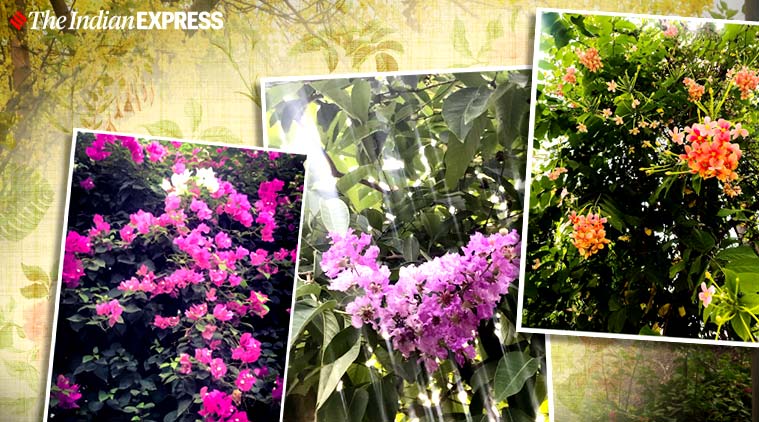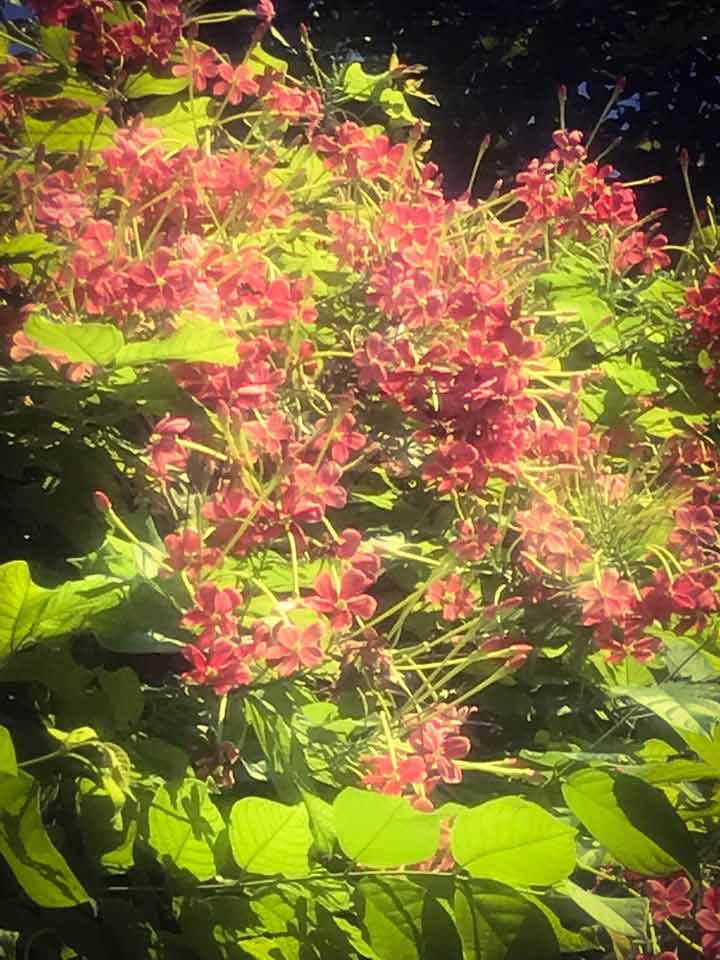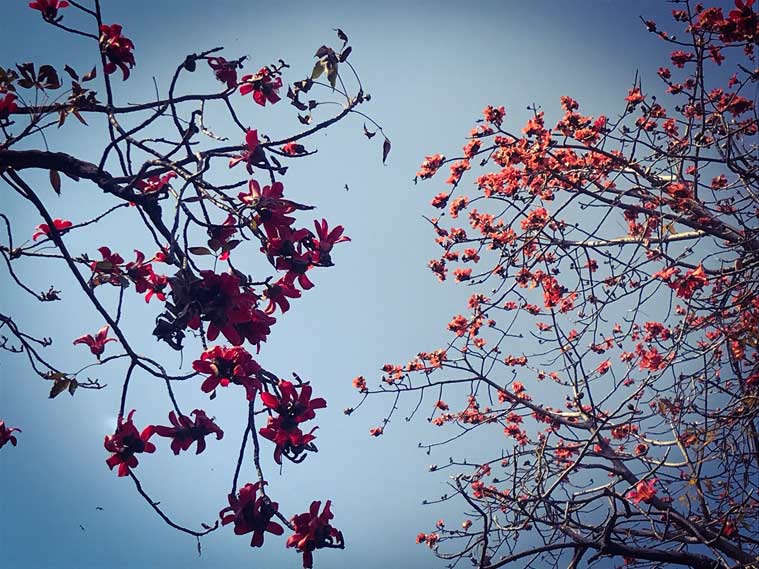 Floral blooms in the scorching summer months lend much respite. These trees that adorn urban eco-scapes provide for the much-needed calm and soothing views. (Photos: Swasti Pachauri; designed by Gargi Singh)
Floral blooms in the scorching summer months lend much respite. These trees that adorn urban eco-scapes provide for the much-needed calm and soothing views. (Photos: Swasti Pachauri; designed by Gargi Singh)
It’s been two months to the lockdown. While this global emergency has beseeched us to pause, slow down, and reflect; it has also given us moments to reminisce over nature’s generosity, like the summery floral abundance — which many of us may have missed to observe and cherish, during these moments of introspection.
Floral blooms in the scorching summer months lend much respite. These trees that adorn urban eco-scapes provide for the much-needed calm and soothing views. For instance, the golden chandeliers and scintillating carpets of Amaltas (Indian Laburnum), blooming red and vermillion Gulmohur (Flamboyant tree), occasional Neeli Gulmohur or Jacaranda danglers, pink, white, and yellow Champa flowers (Magnolia champaca), Peeli Gulmohur (Copper pods), and hanging, fragrant Madhumalti beauties (Rangoon Creeper), not to forget the enigmatic and enticing Mogra (Jasmine) — often welcome the morning walker, while mango, Jamun (Indian blueberry), Bel (golden apple) Katahal (Jackfruit) trees laden with fruits, tempt us all. This time during the lockdown, many of us missed cherishing these fruits of mother nature. So, let us take a moment and remember all that we missed and express gratitude for all that we ever relished.
 Mogra, Madhumalti (above), and Gulmohur have many anecdotal stories associated with them. (Photo: Swasti Pachauri)
Mogra, Madhumalti (above), and Gulmohur have many anecdotal stories associated with them. (Photo: Swasti Pachauri)
The reasons are abundantly obvious. For one, these trees, plants, fruits, and flowers are a sight for sore eyes. Lockdown, no lockdown, the flourishing vegetation not only reminds us of the natural capital, but also add to the cultural capital of our cities, and landscapes as many of these trees have cultural and spiritual significance. For example, flowers of Amaltas are used in the festival of Vishu. Mogra, Madhumalti, and Gulmohur have many anecdotal stories associated with them. Most importantly, these trees add to the biodiversity by hosting a variety of birds, bees, insects, and butterflies.
Next, nature balances its scorching temperatures with the yellow glories of Peeli Gulmohur, and the ever-captivating, welcoming laal Gulmohur. Just preceding the summer season, in fact, floral glories of ‘Semal’, or the Cotton tree, citrus ‘Neroli (Bitter Orange tree) and Palash (flame of the forest) bloom in all their might, beautifying our cities, and of course, the rural geographies, giving us silent moments of acknowledging and appreciating nature. Trees like Peeli Gulmohur is very popular for ornamentation and decoration, reforestation drives along pavements, flyovers, and streets in cities. In addition to the vibrant reds, oranges, and yellow, the season witnesses the calming shades of white, lavender, and violet. The city of Delhi, for example, has certain areas that are witness to the rare calming blooms of beautiful Jacaranda, or Wisteria trees punctuating the city’s lanes and pavements with their violet and lavender floral drops. Similarly, gardens are dotted with fragrant pink, magenta, violet Jarul shrubs (Queen’s flower), and bougainvillea creepers. The hypnotizing fragrance of white Champa and Mogra are other blessings tough to ignore.
 Just preceding the summer season, in fact, floral glories of ‘Semal’, or the Cotton tree, citrus ‘Neroli (Bitter Orange tree) and Palash (flame of the forest) bloom in all their might, beautifying our cities. (Photo: Swasti Pachauri)
Just preceding the summer season, in fact, floral glories of ‘Semal’, or the Cotton tree, citrus ‘Neroli (Bitter Orange tree) and Palash (flame of the forest) bloom in all their might, beautifying our cities. (Photo: Swasti Pachauri)
Most importantly, with the economy opening slowly and steadily with restrictions, in an attempt to tread back to supposed normalcy, we need to remember the vast ecological services trees provide. Not only do these hone the country’s natural infrastructure and green capital, a vast amount of intangible services are added to our economics and heritage, as well. Several vintage trees such as those of Peepal, Ashoka, Neem, and Bargad (Banyan) add to the ancient heritage value of our cities, for instance.
We, as a collective, therefore, must undertake initiatives, once situations ease. The impact of COVID-19 is not just on public health and economics, but also on our psychological wellbeing, as is abundantly clear. To utilise our green and floral capital more effectively in sync with the requirements of healing and wellness, governments could undertake nature-based meditation camps, or even encourage concepts of Yogic kheti, going forward in suitable public spaces and gardens housed in cities. For example, recently tulip gardening was undertaken in the some parts of the Chanakya Puri area, in February, this year by the New Delhi Municipal Council (NDMC).
 flowers of Amaltas are used in the festival of Vishu. (Photo: Swasti Pachauri)
flowers of Amaltas are used in the festival of Vishu. (Photo: Swasti Pachauri)
Similarly, waste management methods of utilising floral waste, foliage, and dry leaves could be initiated. For instance, Semal and Amaltas trees shed their produce in good quantities, the by-products of which could be used in concepts of green manure and compost. Urban Self-Help Groups (SHGs) could be provided alternate means of income by training women and men into producing products such as incense, as is undertaken by many organisations engaged in flower waste management.
These ideas could also be incorporated in the SMART Cities plans across India, which will not only enhance the beautiful green capital of the country but also promote health and wellness among citizens reeling under grave mental stress, currently. Trees provide immense economic, infrastructural, aesthetical, ecological, and health services. Activities such as greening our urban spaces with methods of sustainable floriculture, vertical farming, and green roofs will enhance the natural capital of our landscapes.